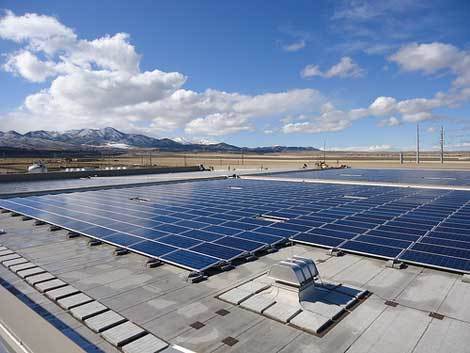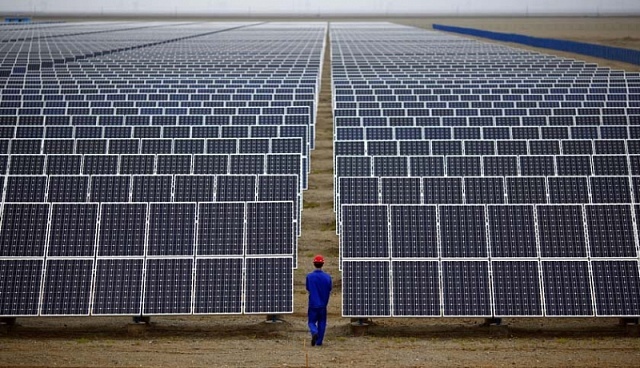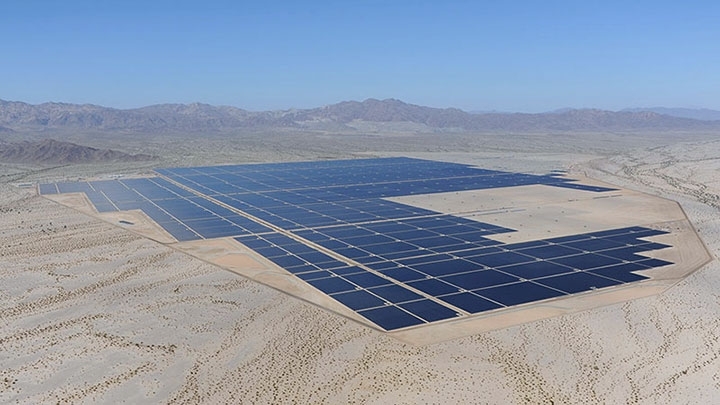Solar energy for data centers
Universal curiosity aroused the news from Apple about the construction of a new data center worth about $ 2 billion, which will receive energy only from renewable sources. After all, this means providing with energy an area of more than 100 thousand square meters. The project is one of the most expensive. A significant part of the power supply will be solar energy from the local Salt River Project company, which has a production capacity of about 70 MW.

Actually, the use of solar energy to power the data center is a popular topic, as well as one of the key in the work of data center designers. Companies are gradually expanding their budgets and allocating money to modernize the infrastructure of their corporate and commercial data centers in order to reduce their carbon footprint. Converting a data center to environmentally friendly renewable energy sources, such as solar, helps reduce the PUE coefficient and the total amount of “dirty” electricity from coal-fired power plants.
')
How can I convert data centers to solar energy?
Option 1 - buy electricity from public utilities

This scheme is guided by Google. The company has been buying electricity from solar power plants, which are located in the same regions as their data centers, for several years. And even if the local public utilities are not always able to meet all the needs of the data center for electricity from renewable sources, the motion vector is clearly correct. In this case, it turns out to reduce the carbon footprint, and at the same time encourage public utilities to invest more funds in the development of generating capacity based on renewable energy sources.
When it is impossible to organize the power supply of the data center directly from the SES, an alternative mechanism comes to the rescue. The so-called "green" certificates that are issued by energy companies and confirm the purchase and use of environmentally clean electricity. Such electricity comes from a conventional central network.
Option 2 - build a local solar farm to partially meet the needs of the data center

With a relatively low capital, you can build a fairly compact local solar farm near the data center with modest power. True, electricity suppliers offering electricity from solar power plants to customers, so far not enough.
If the power of the data center exceeds the power of the solar power plant, then electricity will be consumed directly by the infrastructure of the data center. And then you will not have to deploy additional batteries to store excess electricity, requiring maintenance and periodic replacement. This increases the economic viability of creating a local solar farm. This option is suitable for regions with a high price of electricity from the central grid and / or frequent interruptions in power supply due to which data center operators are forced to use expensive diesel power plants.
Option 3 - build a local solar farm as the main source of electricity

If the budget allows, and there is also a lot of free space near the data center, you can always install an array of solar panels. And such a farm will not only be able to fully meet the needs of the data center for electricity, but even generate extra electricity. These surpluses will remain on storage in batteries, and they will be used at night when the efficiency of the solar power plant tends to zero.
Such a private local solar farm, serving as the primary source of energy, will be able to protect the data center from power outages from the central network. Here you can kill two birds with one stone - to provide a backup source of electricity and get rid of the need to put diesel generators.
The efficiency of solar panels has increased several times. But even in especially sunny regions to support one rack with 5 kW of load, an array of solar batteries of about 39 kW will be needed, which will occupy almost 260 sq. M. And even a small data center on racks 10 will request an array of solar panels with an area of 2600 sq. M.
A successful experience was demonstrated by eBay, which built a Topaz data center in South Jordan (Utah, USA). On the roof of their data center, they created a powerful solar farm. Since Topaz was the first personal data center of eBay, the company did not spare the money for its arrangement and modification. For compliance with all environmental standards, the data center even received a LEED Gold certificate.

SPG Solar specialists were engaged in the placement of a solar panel complex. Solar farm with a total area of 6.7 thousand square meters. occupies almost the entire roof of the data center. In this case, the total generating capacity is approximately 0.67 MW (about 10% of electricity, which is enough for Topaz to operate). The solar farm generates over 920 MWh of electricity annually.
Also, the IBM data center in Bangalore (India) has its own solar farm with a capacity of 50 kW. The electricity generated by this solar power plant is transmitted directly to IT equipment inside the server farm, instead of being transformed into alternating current, and then back into direct current. What helps to prevent 15% power loss.
The basis of the computing infrastructure of the Indian data center consists of modified machines from the System z mainframe line. All mainframes inside the data center not only work on solar energy, but are also cooled with water (heat exchangers are connected to each CPU), which contributes to a further reduction in power consumption.
PS We conduct a campaign specifically for Habr's readers. Post with the details here .

Actually, the use of solar energy to power the data center is a popular topic, as well as one of the key in the work of data center designers. Companies are gradually expanding their budgets and allocating money to modernize the infrastructure of their corporate and commercial data centers in order to reduce their carbon footprint. Converting a data center to environmentally friendly renewable energy sources, such as solar, helps reduce the PUE coefficient and the total amount of “dirty” electricity from coal-fired power plants.
')
How can I convert data centers to solar energy?
Option 1 - buy electricity from public utilities

This scheme is guided by Google. The company has been buying electricity from solar power plants, which are located in the same regions as their data centers, for several years. And even if the local public utilities are not always able to meet all the needs of the data center for electricity from renewable sources, the motion vector is clearly correct. In this case, it turns out to reduce the carbon footprint, and at the same time encourage public utilities to invest more funds in the development of generating capacity based on renewable energy sources.
When it is impossible to organize the power supply of the data center directly from the SES, an alternative mechanism comes to the rescue. The so-called "green" certificates that are issued by energy companies and confirm the purchase and use of environmentally clean electricity. Such electricity comes from a conventional central network.
Option 2 - build a local solar farm to partially meet the needs of the data center

With a relatively low capital, you can build a fairly compact local solar farm near the data center with modest power. True, electricity suppliers offering electricity from solar power plants to customers, so far not enough.
If the power of the data center exceeds the power of the solar power plant, then electricity will be consumed directly by the infrastructure of the data center. And then you will not have to deploy additional batteries to store excess electricity, requiring maintenance and periodic replacement. This increases the economic viability of creating a local solar farm. This option is suitable for regions with a high price of electricity from the central grid and / or frequent interruptions in power supply due to which data center operators are forced to use expensive diesel power plants.
Option 3 - build a local solar farm as the main source of electricity

If the budget allows, and there is also a lot of free space near the data center, you can always install an array of solar panels. And such a farm will not only be able to fully meet the needs of the data center for electricity, but even generate extra electricity. These surpluses will remain on storage in batteries, and they will be used at night when the efficiency of the solar power plant tends to zero.
Such a private local solar farm, serving as the primary source of energy, will be able to protect the data center from power outages from the central network. Here you can kill two birds with one stone - to provide a backup source of electricity and get rid of the need to put diesel generators.
The efficiency of solar panels has increased several times. But even in especially sunny regions to support one rack with 5 kW of load, an array of solar batteries of about 39 kW will be needed, which will occupy almost 260 sq. M. And even a small data center on racks 10 will request an array of solar panels with an area of 2600 sq. M.
A successful experience was demonstrated by eBay, which built a Topaz data center in South Jordan (Utah, USA). On the roof of their data center, they created a powerful solar farm. Since Topaz was the first personal data center of eBay, the company did not spare the money for its arrangement and modification. For compliance with all environmental standards, the data center even received a LEED Gold certificate.

SPG Solar specialists were engaged in the placement of a solar panel complex. Solar farm with a total area of 6.7 thousand square meters. occupies almost the entire roof of the data center. In this case, the total generating capacity is approximately 0.67 MW (about 10% of electricity, which is enough for Topaz to operate). The solar farm generates over 920 MWh of electricity annually.
Also, the IBM data center in Bangalore (India) has its own solar farm with a capacity of 50 kW. The electricity generated by this solar power plant is transmitted directly to IT equipment inside the server farm, instead of being transformed into alternating current, and then back into direct current. What helps to prevent 15% power loss.
The basis of the computing infrastructure of the Indian data center consists of modified machines from the System z mainframe line. All mainframes inside the data center not only work on solar energy, but are also cooled with water (heat exchangers are connected to each CPU), which contributes to a further reduction in power consumption.
PS We conduct a campaign specifically for Habr's readers. Post with the details here .
Source: https://habr.com/ru/post/271075/
All Articles